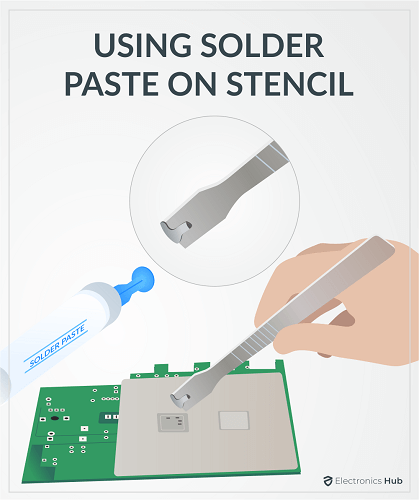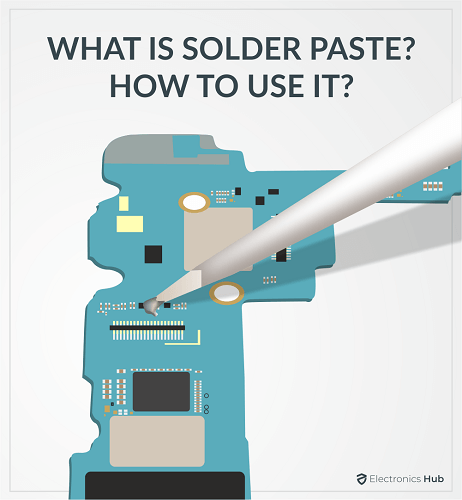Soldering is one of the most reliable techniques to join two materials without fusing them. It is because of the very reason it is used to assemble electronic components in a PCB. If you are working with through-hole components, then a good quality solder wire is sufficient. But if you are assembling a lot of SMD components, then instead of regular solder, you might benefit from Solder Paste. But what is Solder Paste? How to use Solder paste while assembling components on PCB?
The following is a detailed guide on the purpose of solder paste, its types, and how to use it correctly.
What is Solder Paste?
Solder paste is a metal alloy that melts to create a permanent bond between two metals. It is a combination of metal solder particles and sticky flux.
One of the primary requirements of a solder paste is that it should have a low melting point. Only then it will melt sooner than the workpieces to create a joint.
Solder paste is also a relatively good conductor of electricity. It allows solder paste to be used in joining electrical wires and assembling PCBs. Apart from creating a mechanical joint, solder paste also creates an electrical joint between them.
Initially, the solder pastes were made from a mixture of tin and lead. Solder pastes used in electrical soldering consisted of 60% tin and 40% lead. But due to the harmful effects of lead, the modern solder pastes come without lead as well.
Composition of Solder Paste
Solder paste, a crucial element in electronics assembly, comprises two primary components: the solder alloy and flux. The solder alloy forms the metallic bond between components, ensuring electrical conductivity and mechanical stability. It typically consists of a mixture of tin (Sn) and lead (Pb) or other metals in varying proportions, depending on the application’s requirements. Lead-based solder alloys have long been prevalent but are being phased out due to environmental concerns, leading to the widespread adoption of lead-free alternatives.
Flux, the second primary component, plays a multifaceted role in the soldering process. It serves as a cleaning agent, removing oxides from metal surfaces, thereby promoting proper wetting and adhesion. Additionally, flux acts as a deoxidizer, preventing the formation of new oxides during the soldering process. This ensures the integrity of the solder joint and enhances its reliability over time. Flux also aids in controlling the solder’s flow and prevents defects such as solder balling and bridging. It is typically composed of rosin, organic acids, or other chemical agents, each offering specific advantages depending on the application and assembly requirements.
Solder Paste Grades
There are different grades of solder paste available to suit your soldering needs. You have to select the one depending on the type of soldering and the materials you want to solder.
The solder paste is segregated into different grades based on the size of the solder balls. It is not possible to measure the exact size of the balls and grade them. So, the solder paste is graded in such a way that 80% of the balls fall within a size band.
Here is a list of the different types of grades and the size of solder balls in each grade,
| Solder Paste Grade | Particle Size |
|---|---|
| Type 1 | 75mm to 150mm |
| Type 2 | 45mm to 75mm |
| Type 3 | 25mm to 45mm |
| Type 4 | 20mm to 38mm |
| Type 5 | 10mm to 25mm |
| Type 6 | 5mm to 15mm |
| Type 7 | 2mm to 11mm |
| Type 8 | 2mm to 8mm |
Other Types of Solder Paste
Besides the size of solder balls, solder is also categorized into different types based on the flux type and solder type.
- Lead-Based Solder Paste: Traditional solder paste containing lead (Pb) and tin (Sn), often referred to as Sn-Pb solder paste. It has been widely used in electronics manufacturing but is being phased out due to environmental and health concerns.
- Lead-Free Solder Paste: With the push for environmentally friendly manufacturing, lead-free solder pastes have become increasingly popular. These typically contain alloys such as tin-silver-copper (Sn-Ag-Cu) or tin-silver-copper-bismuth (Sn-Ag-Cu-Bi). They offer comparable performance to lead-based solder paste but without the environmental hazards.
- No-Clean Solder Paste: This type of solder paste leaves minimal to no residue after soldering, eliminating the need for cleaning the PCB afterward. It contains flux that is designed to decompose during reflow soldering, leaving behind a subtle residue that doesn’t affect the performance of the circuit.
- Water-Soluble Solder Paste: Unlike no-clean solder paste, water-soluble solder paste leaves a residue after soldering that can be easily removed with water. It contains flux that can be dissolved in water, facilitating cleaning of the PCB after soldering. This type is often used when cleanliness is a critical concern.
- Rosin-Based Solder Paste: Solder pastes containing rosin flux are known for their excellent wetting properties and are often used for hand soldering or rework applications. However, they typically require cleaning after soldering due to the flux residue they leave behind.
- Halogen-Free Solder Paste: Halogens, such as chlorine and bromine, can be present in fluxes used in solder paste. Halogen-free solder pastes are formulated without these halogens, which is beneficial for applications where halogen-free materials are required, such as in certain aerospace and military applications.
- Low-Temperature Solder Paste: These solder pastes are designed to reflow at lower temperatures compared to standard solder pastes. They are used for components that are sensitive to heat or for substrates that cannot withstand high temperatures.
How to Use Solder Paste?
Whether you are using the solder paste in mass PCB assembly or prototype PCB assembly, you have to follow certain steps precisely.
Apply Solder Paste
First, you have to apply the solder paste on the circuit boards. While doing this, you have to make sure that you are applying only to the areas where you will be soldering.
There are different methods to achieve this. We have listed two of the most popular methods to apply solder.
Using Stencil

Place the stencil over the board and apply the solder paste through this. You have to make sure that you apply the required amount of solder paste. If you apply too little, the joints will not be strong and break easily.
On the other hand, if you apply too much, the joints will become too large. Besides, it will lead to the possibility of shorts between adjacent pads.
Using Jet Printer
Although stencil does a good job in applying solder for mass PCB assemblies, you have to spend a lot of time building a stencil depending on the PCB assembly pattern. Besides, it is also difficult to control the amount of solder you apply to the board.
A jet printer overcomes these drawbacks. But jet printing is not suitable for all solder paste types. The solder paste should be more liquid if you want to jet print it.
The jet printer is programmed depending on the PCB assembly pattern. It has a cartridge in which you have to fill the solder paste.
The printer then applies the correct amount of solder paste to the required areas on the board. Jet printing the solder paste provides more flexibility and increases the precision with which you apply the solder paste.
Assembling the Electronic Components
Once you have applied the solder paste on the circuit board, you have to pass it through the pick and place machine.
Like applying the solder, assembling the components on the solder also has different methods. To start with, you go with the pick and place machine. It is one of the simplest and easiest techniques. The pick and place machine adds the electrical components in the areas where you have applied the solder.
There are different methods to assemble the electrical components on PCB. However, the pick and place machine offers the simplest and reliable way for PCB assembly. You may also opt for other methods such as reflow soldering. When the pick and place machine adds the components, the solder will hold the components due to the surface tension.
During this stage, you have to keep two things in mind. You should not knock or disturb the board. If you do, the components might fall off. Also, if you take too long to solder the components, the solder paste will deteriorate and won’t hold the components.
Solder Paste Storage
When storing the solder paste, you have to make sure that the environment and temperature are suitable for it. If not, the solder paste will lose its properties and will become useless.
Solder pastes are prone to oxidation due to the large surface of the solder spheres. So, to prevent this, you have to store them in airtight containers. Besides, you have to store them at low temperatures. Apart from minimizing the oxidation rate, the low temperature reduces the rate of degradation of the flux. However, you also have to make sure that the temperature does not drop below the freezing point.
Every solder paste comes with a shelf life. You can see the shelf life on its label. Never use a solder paste beyond its shelf life. The joints created by these solder pastes won’t be strong nor reliable. Such joints will break easily and you will end up spending more to replace the entire circuit board.
Frequently Asked Questions
What are the main components of solder paste?
Solder paste typically consists of three main components: solder powder, flux, and a solvent or vehicle. The solder powder is usually made of an alloy, such as tin-lead or lead-free compositions like SAC (tin-silver-copper). The flux is a chemical agent that facilitates the soldering process by cleaning, wetting, and preventing oxidation. The solvent or vehicle helps keep the paste at a workable consistency and evaporates during the reflow process.
How to apply solder paste to a PCB?
Solder paste is applied to the PCB using a stencil. The stencil is a thin metal sheet with openings that correspond to the locations of surface-mount components on the PCB. The solder paste is spread evenly over the stencil, and a squeegee is used to force the paste through the openings onto the PCB. Excess paste is then removed, leaving precise deposits of solder paste on the PCB pads.
What is role of solder paste in reflow soldering?
Reflow soldering is the most common method for assembling surface-mount components to PCBs. In this process, the PCB with solder paste deposits is placed in a reflow oven, where it is subjected to controlled heating. As the temperature rises, the solder paste melts, creating a liquid phase that forms solder joints between the component leads and the PCB pads. Once the solder cools and solidifies, the components are securely attached to the PCB.
What are the different types of solder paste available?
There are various types of solder paste available, differentiated by factors such as alloy composition, flux type, particle size, and application method (e.g., syringe dispensing vs. stencil printing). When choosing the right solder paste, consider factors like the specific requirements of your application (e.g., lead-free vs. leaded solder, high-temperature vs. standard reflow), compatibility with the components being soldered, and the assembly process used.
Conclusion
Solder paste acts as a key element in the soldering process by creating reliable joints, allowing electrical conductivity, and protecting the workpieces against corrosion and oxidation.
But, to achieve all these purposes, you need to choose the correct type of solder paste. Once chosen, you can apply the solder paste on the workpieces and use a relevant soldering technique to get the work done.
If you have any other queries or doubts, let us know using the comments section. We will help you out. You can also post your thoughts and opinions in the comments box.


